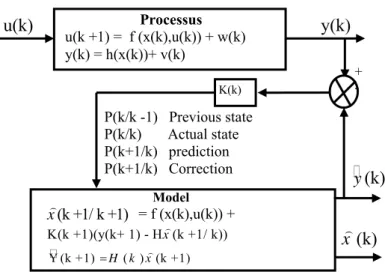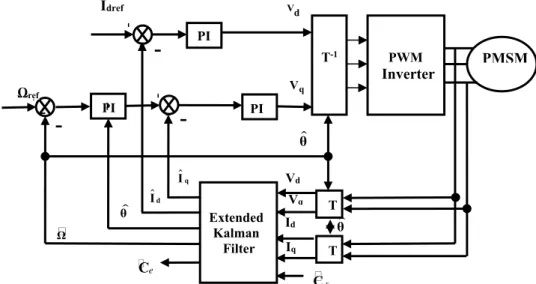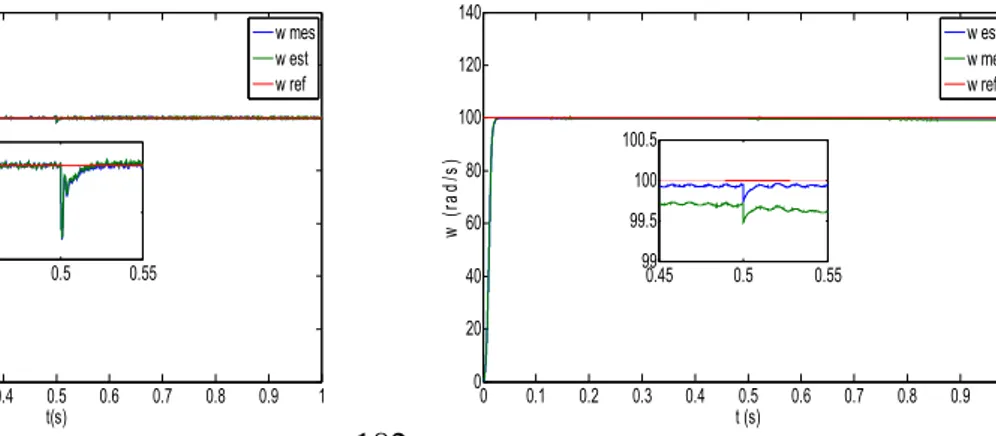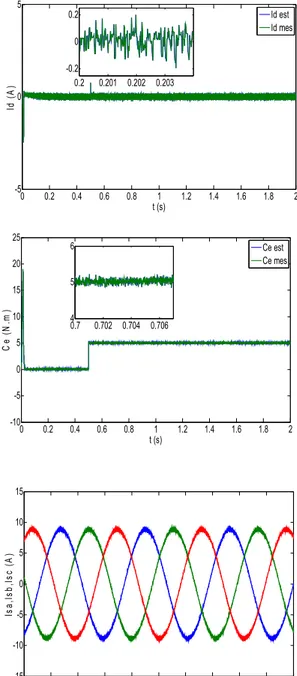Selçuk-Teknik Dergisi ISSN 1302-6178 Journal of Selcuk-Technic
Özel Sayı 2018 (ICENTE’17) Special Issue 2018 (ICENTE'17)
173
COMPARATIVE STUDY BETWEEN SENSORLESS VECTOR CONTROL AND NONLINEAR CONTROL FOR PMSM BASED ON EXTENDED
KALMAN FILTER (EKF)
Yacine MAANANI1+, ArezkiMENACER, Imadeddine HARZELLI
Electrical Engineering Laboratory of Biskra, University of Biskra, Algeria yacine.maanani@gmail.com, menacer_arezki@hotmail.com,
imadeddineharzelli@yahoo.fr
Abstract
This paper presents the performance of sensorless nonlinear control compared with vector control of permanent magnets synchronous machine. The speed estimation is done by Extended Kalman Filter (EKF). The robustness of the control is tested for the parameter variation and for the machine operating at low speed. The simulation results show the robustness of the filter and the overall drive system.
Keywords: permanent magnets synchronous machine, vector control, input/output
control, estimation, EKF.
1. Introduction
Permanent magnets synchronous machines are spreading more and more as actuators in automated industries where they replace the DC motors. They have about them the advantage of having better performance (in terms of mass torque, for example) and not having mechanical commutator (collector that pose maintenance problems and behavior in difficult environments) [1], [2].
Vector control results in electric drives with a dynamic very similar to using the DC machines. This structure, which is generally decoupled control of torque and flux. However, this control structure requires that the machine settings are accurate. This requires proper identification of parameters. Accordingly, the use of robust control algorithms, to maintain a level of decoupling and acceptable performance is necessary. Nonlinear control has the advantage of separately current and torque. With this control technology, engine model is broken down into two independent systems mono variable + This paper has been presented at the ICENTE'17 (International Conference on Engineering
Selçuk-Teknik Dergisi ISSN 1302-6178 Journal of Selcuk-Technic
Özel Sayı 2018 (ICENTE’17) Special Issue 2018 (ICENTE'17)
174
linear. Each subsystem is an independent control loop of a given variable (speed, torque, current,.. etc.). The dynamics of the linearized system is chosen through optimal taxation of poles [3].
The sensorless control strategy for permanent magnet synchronous machine (PMSM) has become a center of intensive research and development. Researchers want to avoid the problems encountered in regulatory systems, caused by the inherent imperfections of rotational motion sensors used. The incorporation of these systems may increase in complexity and size. It can also degrade the performance of the control. For these reasons, the elimination of these sensors is essential [4].
2. Mathematical Model OFPMSM
The electrical equation of the PMSM in the rotor reference (d-q) frame is as follows:
The general mechanics equation is given by:
e r dΩ . f.Ω C C dt J (2) The electromagnetic torque is given by the following expression:
e 3 d q d q f q C P (L L )i i φ i 2 (3) where:
Vd ,Vq : direct and quadrature voltages,
Id, Iq : direct and quadrature current,
Rs : stator resistances,
Ld, Lq : Direct and quadrature inductances,
Ce : electromagnetic torque,
Ω : mechanical rotation velocity, p : number pairs of poles,
J : rotor inertia,
f : viscous friction coefficient,
r q d s d d d d d q r f q r d s q q q q ω .L V R L i L L i d V ω .φ i ω .L i dt R L L L (1)
Selçuk-Teknik Dergisi ISSN 1302-6178 Journal of Selcuk-Technic
Özel Sayı 2018 (ICENTE’17) Special Issue 2018 (ICENTE'17)
175
(6)
(7)
f
φ : flux established by rotor permanent magnets.
3. Direct Vector Control OFPMSM
Direct vector control of PMSM is based on a conventional method of compensation, it is to regulate two currents id and iq neglecting the coupling terms, the latter being
added to the output of the correction currents to obtain tensions of Vdref and Vqref order.
To ensure the decoupled structure, the f.e.m (ed, eq) of compensation are added to the output regulators, such as [5]:
' q q q ' q d d V V e V V e (4) with: q r d d r f r q q d e ω .L .I ω .P.φ e ω .L .I (5) For currents Id and Iq, and speed the PI regulators are selected.
4. Input-Output linearization of the PMSM
Linearization condition for checking whether a nonlinear system admits an input output linearization is relative degree of the system [6].
The degree relative with respect to the output y ( )1 x is
f d 1 g 1( ) ( ) d ( y x h x L h1 x) L h1( )x U f1 g V1 Or x is state vector, the functions f, g and h are analytic.
The relative degree is r1 = 1 gives:
2 2 2 3 2 f y ( )x h ( )x L h ( ) Lx gh ( )x Uf Or: Lgh )2(x 0 y2( )x L hf 2(x ) f 3
The derivative of the second output does not involve input U; you must derive a second time this output:
The derivative of h x2
dregs on g is zero, the (7) can be written as:f 2 2 2 2 2 f y ( ) hx ( )x L h (x) L L hg ( ).x U with:
Selçuk-Teknik Dergisi ISSN 1302-6178 Journal of Selcuk-Technic
Özel Sayı 2018 (ICENTE’17) Special Issue 2018 (ICENTE'17)
176 (8)
d q
d q
2 f 2 1 2 2 f 1 3 L L L p φ f ( ) L L h f f f j p j j j p x x x
d q
d q
f d d f 2 2 1 L L L L p L L h p p L j φ 1 1 ( ) j L j g x x x The relative degree relative to y2 and r2 = 2.
The relative degree of the system is r = r1 + r2 = 3.
The system is exactly linearizable r = n = 3, and n is the order of 1 system. Finally, the input-output relationship model is given by:
d 1 2 2 2 ( ) ( ) ( ) d I y dt Vd A D Vq d y dt ( ) x x x x or:
d q
1d q
f 1 2 2 1 3 f ( ) f p f p p φ f f j j j j L L L L A x x x
d q
d q
1 f 1 2 2 1 g D L L L L p g p p 0 ( ) φ j j j x x g x If the determinant of the decoupling matrix is not zero, the control condition (NL) is defined by a relationship that connects the new internal inputs (V1, V2) to physical input
(Vd, Vq). d 1 1 q 2 ( ) ( ) V V D A V x x V (9) D: is the decoupling matrix.
By replacing the term (3) in (9), we obtain a linearized and decoupled system:
1 1 2 2 2 d 2 d I y d t V V d y d ) t ( ( ) x x (10)
Selçuk-Teknik Dergisi ISSN 1302-6178 Journal of Selcuk-Technic
Özel Sayı 2018 (ICENTE’17) Special Issue 2018 (ICENTE'17)
177
(14)
5. Non-linear control for thePMSM
Linearization condition for checking whether a nonlinear system admits an input output linearization is one degree of the system. [6]
1 11 dref d d dref V = K (I - I ) + I dt (11) 2 dref dref 1 22 dref d 21 2 d d d V = K ( - ) + K ( - ). dt dt dt (12) Closed loop tracking, error is:
1 11 2 2 21 2 22 2 2 d K 0 dt d d K K 0 dt dt e e e e (13) with: 1 dref d 2 ref d I I e e
The coefficients k11, k21, k22 are chosen such that:
11 2 21 22 P k 0 P k P k 0
6. Extended Kalman Filter(EKF)
The EKF linearized the state and measurement equations about the predicted state as an operating point [7].
This filter is based on a number of assumptions, including noise. Indeed, it assumes that the noise affecting the model are centered and white and that they are uncorrelated estimated states, in addition, the state must be uncorrelated noise measurement noise. 6.1. Algorithm
Given the non-linear stochastic model follows:
X(k 1) f (X(k),u(k)) w(k) Y(k) h(X(k)) v(k) with:
Selçuk-Teknik Dergisi ISSN 1302-6178 Journal of Selcuk-Technic
Özel Sayı 2018 (ICENTE’17) Special Issue 2018 (ICENTE'17)
178 v(k) : Measurement noise vector.
This nonlinear system is brought back into a linear system and infers the set of equations of the EKF. The estimation procedure consists of two steps:
Step 1: Phase prediction • Estimate form of prediction:
x(k 1)/k f(x(k/k),u(k)) (15) This step will build a first estimate of the state vector at time k + 1. It then seeks to determine its variance.
• Calculation of the prediction error covariance matrix:
T P(k +1/ k) = F(k) P(k) F(k) + Q (16) with: T (k) = (k / k) f x(k),u(k)) F(k)= x (k) x x
Step 2: Correction phase
In fact, the prediction phase allows a difference between the measured output yk + 1
and the predicted outputyk 1/ k . To improve the state, it must be take account of this difference and correct it through the filter gain Kk + 1. By minimizing the variance of the
error, the following expressions are obtained: Calcul of the Kalman gain:
T T -1 K(k +1) = P(k +1/ k).H(k) (H(k).P(k +1/ k).H(k) + R) with: (k) = (k) h (x(k)) H (k)= x(k) x x
Covariance matrix calculation of the filter error:
P (k +1/ k +1) = P (k +1/ k) - K (k +1) H (k) P (k +1/ k) (17) Estimation of the state vector at time k +1:
(k +1/ k +1) = (k +1/ k) + K (k +1) (y (k +1) - H. (k +1/ k))
x x x (18)
Selçuk-Teknik Dergisi ISSN 1302-6178 Journal of Selcuk-Technic
Özel Sayı 2018 (ICENTE’17) Special Issue 2018 (ICENTE'17)
179
f (x(k),u(k)) = I I d q C e
Figure 1: Principle of a Kalman Filter.
7. Sensorless control of PMSM based onEKF
The choice of reference for the implementation of the EKF is essential. The ideal case would be to use the repository Park to the rotor.
In our case, we chose a model with reference to the rotor and the EKF is used to estimate the state vector xk consists of (currents Id and Iq, the shaft velocity, values of
angular position and the electromagnetic torque Ce). This non-linear model assumes
that the mechanical speed is a state and not a setting. The model of the PMSM can be in the form: X (k) = f (X (k),u(k)).w (k) Y (k) = h(X (k)).v(k) (19) with: Model (k +1/ k +1) x = f (x(k),u(k)) + K(k +1)(y(k+ 1) - H (k +1/ k))x ( Y (k +1) H k x)(k +1) Processus u(k +1) = f (x(k),u(k)) + w(k) y(k) = h(x(k))+ v(k) P(k/k -1) Previous state P(k/k) Actual state P(k+1/k) prediction P(k+1/k) Correction K(k) y(k) u(k) x(k) y(k) +
-Selçuk-Teknik Dergisi ISSN 1302-6178 Journal of Selcuk-Technic
Özel Sayı 2018 (ICENTE’17) Special Issue 2018 (ICENTE'17)
180 f (x(k),u(k))
=
1 (1-Ts ) Ts 0 0 φf 1 Ts (1-Ts ) 0 φf f 1 Ts Ts (1-Ts ) Ts 0 0 0 0 0 0 0 0 0 0 L R q s Id p Iq Ts Vd Ld Ld Ld L R d s p Id Id Ts p Ts Vq Lq Lq Lq Lq Ld Ld p I Id q p Iq Cr J J J J and: T h I I qd
7.1. Determination of matrices F and H
The linearization matrices F and H allow us to linearize the system every minute of operation. They are given as follows:
1- Ts Ts 0 0 φf - Ts 1-Ts (- ) 0 0 φf Ts T (s ) (1-Ts ) 0 - 0 0 Ts 1 0 0 0 0 0 1 L L Rs q q p Ts Iq Ld Ld Ld Ld Rs Ld p Ts Id Lq Lq Lq Lq F Ld Lq Ld Lq f T s p Iq p Id J J J J J and: 1 0 0 0 0 H(k)= 0 1 0 0 0
Figures 2-3 show the overall patterns of simulated vector control and the nonlinear control of PMSM, The resulting model is then estimated using the EKF.
Selçuk-Teknik Dergisi ISSN 1302-6178 Journal of Selcuk-Technic
Özel Sayı 2018 (ICENTE’17) Special Issue 2018 (ICENTE'17)
181
Figure 2: Sensorless direct vector control of the PMSM
Figure 3: Sensorless nonlinear control of the PMSM
7.2. Selection of covariance matrices Q and R
Via these matrices that pass different states measured, estimated or predicted. Their goal is to minimize errors associated with an approximate modeling and the presence of noise on the measurements. This setting requires special attention and only online control to validate the operation of the filter. However, some guidelines for understanding the influence of the adjustment of these values in relation to the dynamics and stability of the filter.
The Q matrix related to noise marring the state, sets the estimated quality of the considered model and its discretization. A high Q value provides a high value of gain K minimizing the importance of modeling and dynamics of the filter. The measure then
+ + +
-r C e C T T I
Idref Vd Vq Iq Id T-1 Extended Kalman Filter θ PMSM θ Vd Vq Ωref - - - PWM Inverter Ω θ Id Iq PI PI PI e C Extended Kalman Filter N.L.C PWM Inverter PMSM Vd Vq Vd Vq d I Iq Ω ref T-1 T T dref I Ω Id q I θ
Selçuk-Teknik Dergisi ISSN 1302-6178 Journal of Selcuk-Technic
Özel Sayı 2018 (ICENTE’17) Special Issue 2018 (ICENTE'17)
182
has a greater relative weight. Too high a value of Q may also cause instability of the observer.
R rule matrix, in turn, measures the weight. A high value indicates an uncertainty of measurement. By cons, a low value can give significant weight to the measure. However, beware the risk of instability at low values of R.
8. Simulation Results
In order to understand the performance of control with EKF for the PMSM drive, a system is simulated for various tests for either vector control or the non-linear control speed.
Figure 4 shows the step response of mechanical speed, direct currents and stator and the electromagnetic torque of PMSM with a sensorless control using EKF. First, a test with no load at nominal speed set point 100 rad/s, is effected, then a load torque 5 N.m is applied at time t = 0.5 s. It's noted that:
The non-linear control is more robust during load variation, for the vector control the speed reaches 98.496 rad/sec and 99.79 rad/sec for the non-linear control, the speed non-linear control faster than the vector control reaches the nominal value at time 0.04s, against FOC by 0.1s.
Regarding the electromagnetic torque follows much the load torque for both commands when load torque application, it's noted that the torque obtained by vector control reaches the value 7.87Nm, by the torque against the non-linear control has a max value of 5.1Nm, but the chattering is more important for vector control for both currents streams and quadratic.
The stator currents are close to the sine wave for the non-linear control. The harmonic distortion THD=2.04% for vector control and THD=0.67%, to control input-output linearization. 0 0.1 0.2 0.3 0.4 0.5 0.6 0.7 0.8 0.9 1 0 20 40 60 80 100 120 140 t(s) W( ra d /s ) 0.45 0.5 0.55 98 99 100 w mes w est w ref 0 0.1 0.2 0.3 0.4 0.5 0.6 0.7 0.8 0.9 1 0 20 40 60 80 100 120 140 t (s) w (r ad /s ) 0.45 0.5 0.55 99 99.5 100 100.5 w est w mes w ref
Selçuk-Teknik Dergisi ISSN 1302-6178 Journal of Selcuk-Technic
Özel Sayı 2018 (ICENTE’17) Special Issue 2018 (ICENTE'17)
183
Figure 4: Sensorless vector control and nonlinear control using EKF for PMSM
0.6 0.62 0.64 0.66 0.68 0.7 0.72 0.74 0.76 0.78 0.8 -15 -10 -5 0 5 10 15 t(s) Is a; Is b ,Is c (A ) 0.6 0.62 0.64 0.66 0.68 0.7 0.72 0.74 0.76 0.78 0.8 -15 -10 -5 0 5 10 15 t (s) Is a,Is b, Is c (A ) 0 0.1 0.2 0.3 0.4 0.5 0.6 0.7 0.8 0.9 1 -5 0 5 t(s) Id ( A ) 0.2 0.202 0.204 -0.5 0 0.5 Id est Id mes 0 0.2 0.4 0.6 0.8 1 1.2 1.4 1.6 1.8 2 -5 0 5 t (s) Id ( A ) 0.2 0.201 0.202 0.203 -0.2 0 0.2 Id est Id mes 0 0.1 0.2 0.3 0.4 0.5 0.6 0.7 0.8 0.9 1 -10 -5 0 5 10 15 20 25 t (s) Ce ( N. m ) 0.7 0.702 0.704 0.706 4 5 6 Ce est Ce mes 0 0.2 0.4 0.6 0.8 1 1.2 1.4 1.6 1.8 2 -10 -5 0 5 10 15 20 25 t (s) Ce ( N .m ) 0.7 0.702 0.704 0.706 4 5 6 Ce est Ce mes 0 0.1 0.2 0.3 0.4 0.5 0.6 0.7 0.8 0.9 1 0 1 2 3 4 5 6 7 8 9 t (s) w ( rad/ s) 0.25 0.3 0.35 3.5 4 4.5 5 5.5 0.65 0.7 0.75 4.5 5 w mes w est w ref 0 0.1 0.2 0.3 0.4 0.5 0.6 0.7 0.8 0.9 1 0 1 2 3 4 5 6 7 8 9 t (s) w ( rad/ s) 0.25 0.3 0.35 4.2 4.4 4.6 4.8 5 5.2 0.65 0.7 0.75 5 5.2 w mes w est w ref
Selçuk-Teknik Dergisi ISSN 1302-6178 Journal of Selcuk-Technic
Özel Sayı 2018 (ICENTE’17) Special Issue 2018 (ICENTE'17)
184
Figure 5: Sensorless vector control and nonlinear control using EKF for PMSM at low speed and with stator resistance variation
Figure 5 shows the robustness of the control for the stator resistance variation at time t= 0.7sec when the machine operate at low speed. For the vector control the speed and torque are affected by the variation in contrary for the input output control the variation not affect the speed and electromagnetic torque.
9.Conclusion
In this paper, a comparative study of the sensorless vector control and nonlinear control for the permanent magnets synchronous machine PMSM is considered. The shaft velocity, currents Id and Iq, values of angular position and the electromagnetic
torque is then estimated using the EKF.
The results obtained show the effectiveness of the EKF for the stator resistance variation test as well as insensitivity to variations of the load.
The nonlinear control has the advantages namely robustness, high accuracy, stability and simplicity, very low response time, compared to the sensorless vector control using the EKF.
10. Appendix
Ld = 5.8mH, Lq = 5.8 mH, ɸf = 0.1546 Wb, Rs = 1.4Ω, p=3, J = 0.00176 kg.m2,
f = 0.000388 N.m.s/rad.
REFERENCES
[1] HU JIAN, YANG QIU, LU HUI, "Robust nonlinear feedback control of chaos in
0 0.1 0.2 0.3 0.4 0.5 0.6 0.7 0.8 0.9 1 -5 0 5 10 15 20 t (s) Ce ( N. m ) 0.2 0.2020.2040.2060.208 -0.5 0 0.5 0.654 0.7 0.75 5 6 Ce est Ce mes 0 0.1 0.2 0.3 0.4 0.5 0.6 0.7 0.8 0.9 1 -5 0 5 10 15 20 t (s) Ce ( N .m ) 0.65 0.7 0.75 4.5 5 5.5 0.2 0.2020.2040.206 -0.2 0 0.2 Ce est Ce mes
Selçuk-Teknik Dergisi ISSN 1302-6178 Journal of Selcuk-Technic
Özel Sayı 2018 (ICENTE’17) Special Issue 2018 (ICENTE'17)
185
PMSM system with modeling uncertainty", Applied mathematical modeling, 2016.
[2] MARK A. P, R. VAIRAMANI, G.C.R. IRUDAYARAJ, "Mathematical modeling and analysis of different vector controlled CSI Fed 3 phase induction motor", J. Appl. Math., 623982-1-623982-13, 2014.
[3] JINPENG YU, PENG SHI, DONG WENJIE, " neural network-based adaptive dynamic area control for permanent magnet synchronous motors", IEEE Trans Neural Networks and is learning system, 2014.
[4] S. YANG AND R. LORENZ, "Surface permanent-magnet machine self-sensing at zero and low speeds using improved observer for position, velocity and disturbance torque estimation", IEEE Trans Industry Applications, vol. 48, No 1, pp. 151-160, Jan/Feb.2012.
[5] Y. ZHAO, W. QIAO, AND L. WU, "An adaptive quasi sliding-mode rotor position observer based sensorless control for interior permanent magnet synchronous machines", IEEE Trans. Power Electronics, vol. 28, no. 12, pp. 5618-5629, Dec. 2013.
[6] L. HARNEFORS AND M. HINKKANEN, "Stabilization methods for sensorless induction motor drives -A survey", IEEE Journal of Emerging and Selected Topics in Power Electronics, vol. 2, no. 2, pp. 132-142, June 2014.
[7] Y. SHI, K. SUN, L. HUANG, AND Y. LI, "Online identification of permanent magnet flux based on extended Kalman filter for IPMSM rive with position sensorless control", IEEE Trans. Industrial Electronics, vol.59 , no 11pp.4169-4178, Nov 2012.




